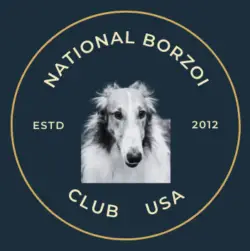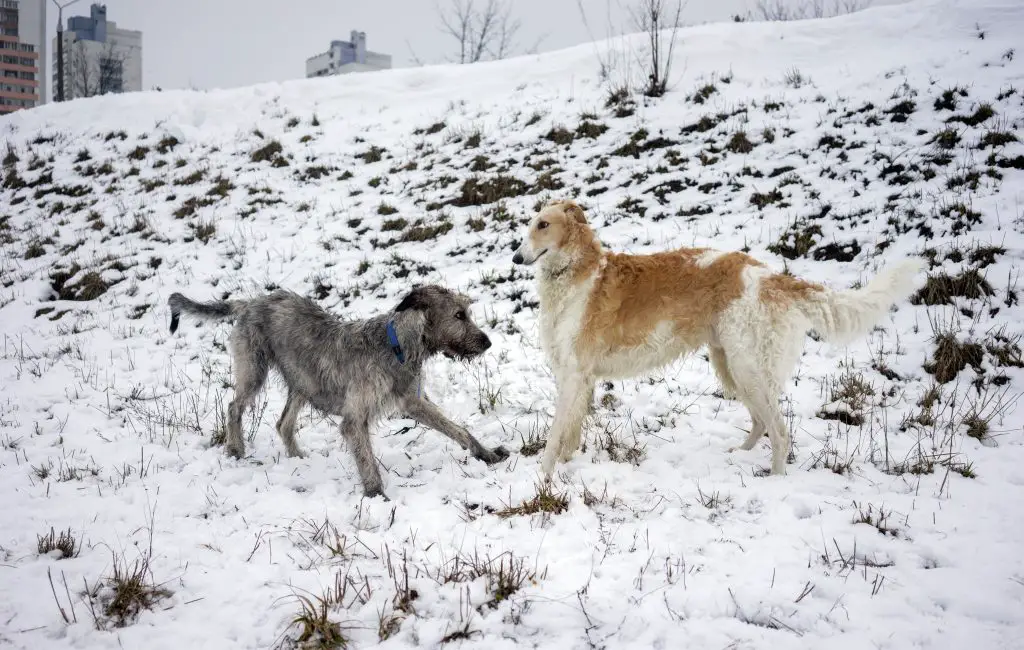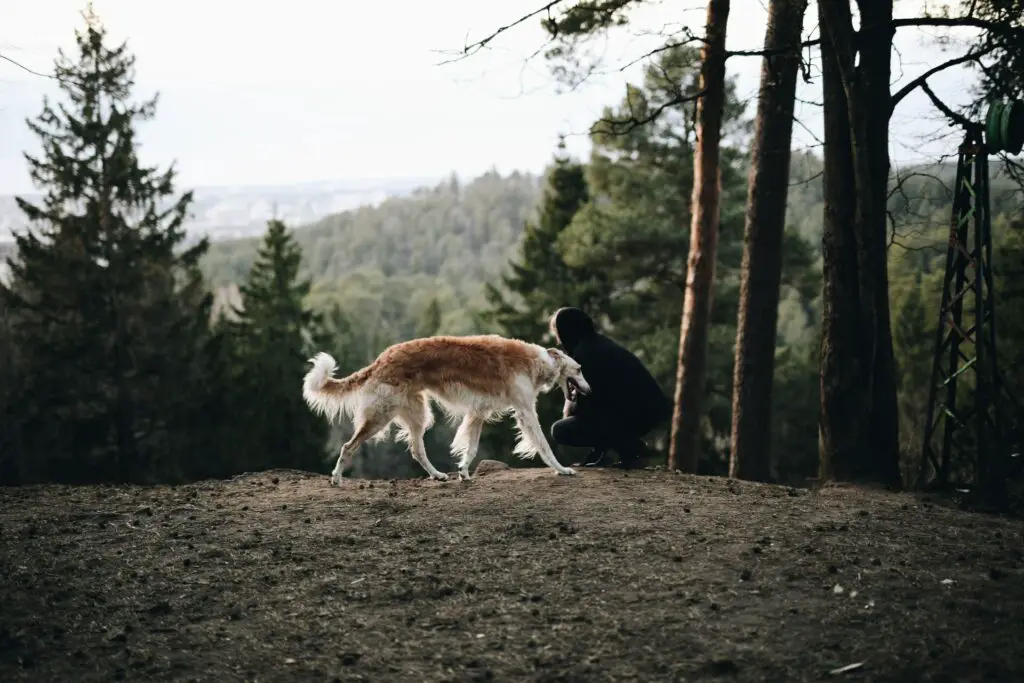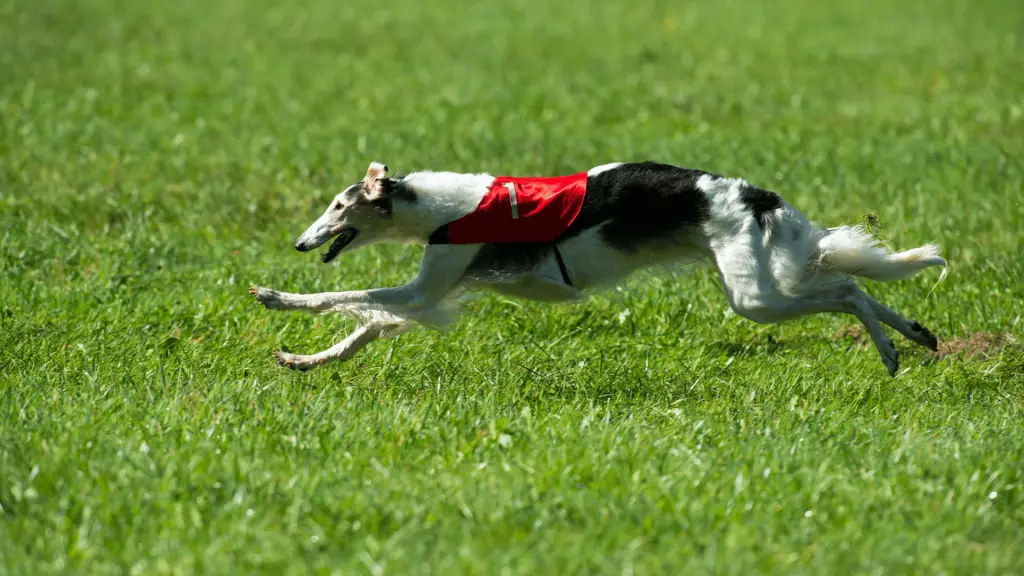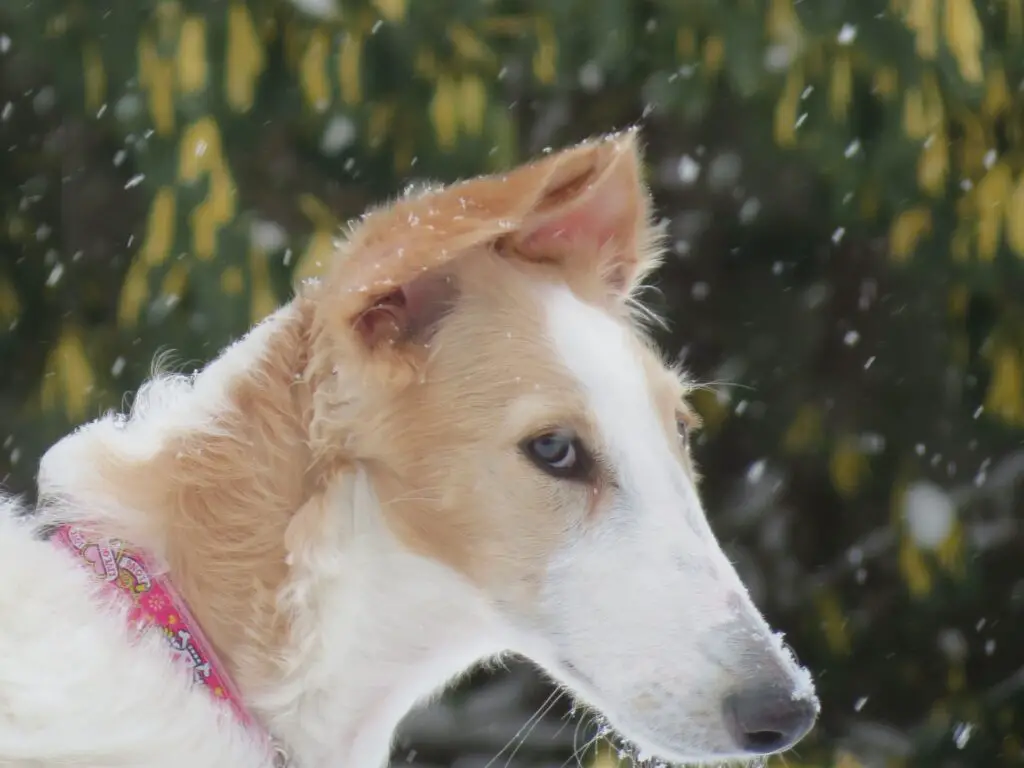Who doesn’t love a giant breed? We certainly do!
Borzois and Irish Wolfhounds are giant, long-haired sighthounds. They were both bred to hunt large game, including wolves! These laid-back dogs are quite similar to one another, with key differences including grooming maintenance, size, and lifespan.
If you’re looking for a new furry friend, Borzois and Irish Wolfhounds are both excellent dogs. While they aren’t recommended for inexperienced dog owners, they’re great family pets for those with large yards and the ability to stay patient during training.
In this article, we’ll discuss the similarities and differences between these sighthounds and help you to determine which, if either, is right for you.
Table of contents
- Borzoi vs Irish Wolfhound
- Borzoi vs Irish Wolfhound Appearance
- Borzoi vs Irish Wolfhound Cost
- Borzoi vs Irish Wolfhound Temperament
- Borzoi vs Irish Wolfhound Exercise
- Borzoi vs Irish Wolfhound Grooming
- Borzoi vs Irish Wolfhound Environmental Needs
- Borzoi vs Irish Wolfhound Health
- Borzoi vs Irish Wolfhound History
Borzoi vs Irish Wolfhound
Borzois and Irish Wolfhounds are both longer-haired sighthounds with double coats. However, the Irish Wolfhound’s wiry fur requires much less maintenance.
These dogs are giant breeds that require lots of exercise. Due to their independent natures, they can be difficult to train and aren’t recommended for inexperienced dog owners.
Of course, as with anything, the best dog for you will depend upon your lifestyle and what you’re looking for in a dog. While these breeds are remarkably similar, they do have a few differences to take into account such as grooming time, lifespan, and size.
Here is a quick rundown of each breed’s key features:
| Borzoi | Irish Wolfhound | |
| Lifespan | 9-14 years | 6-8 years |
| Energy | High | High |
| Grooming | High | Average |
| Trainability | Intermediate | Intermediate |
| Size | Giant | Giant |
Borzoi vs Irish Wolfhound Appearance
Both of these dogs have the deep chest and thin waist typical of sighthounds. However, Irish Wolfhounds are much stockier than Borzois. Their muscular body is covered with long, wiry fur in a variety of colors.
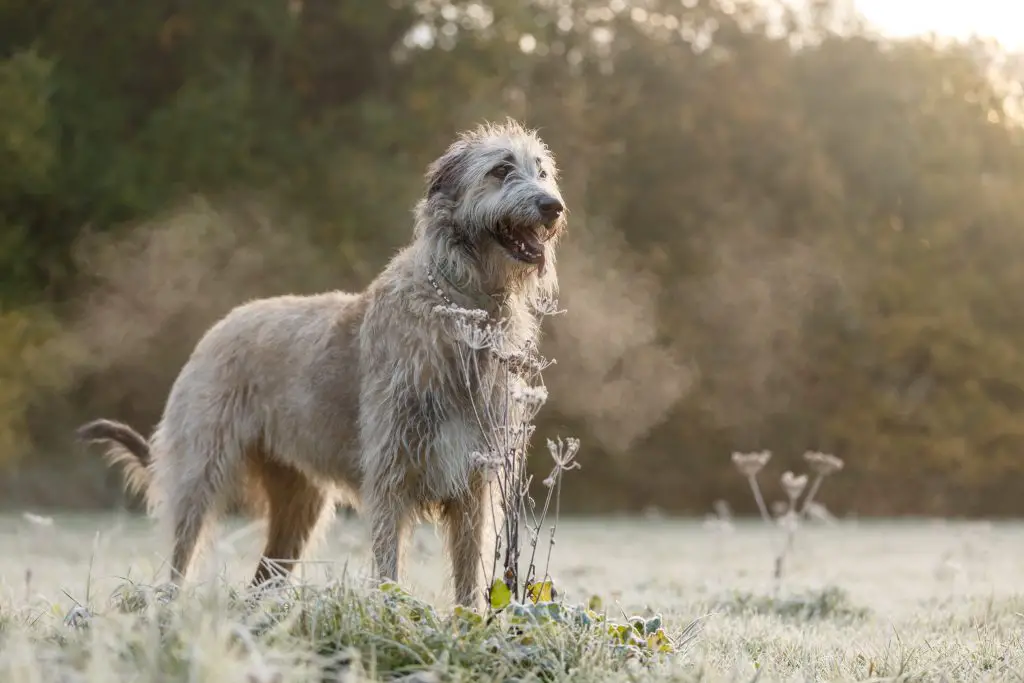
Borzois have skinnier frames and long, soft, curly coats. Their fur can be a variety of colors and patterns, with none ruled out according to breed standards.
Borzoi females stand at 26 inches or taller, while males are at least 28 inches in height. They weigh 60-105 pounds.
Irish Wolfhounds are even bigger than this, with females standing at 30 inches minimum and males at 32 inches and up. They weigh 105-120 pounds.
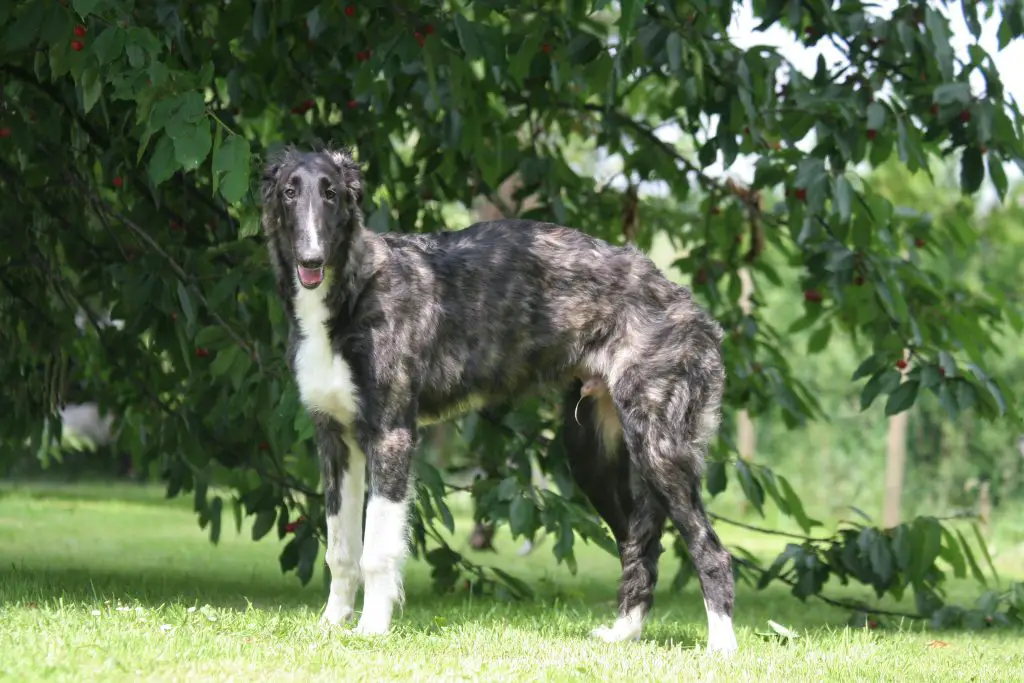
Borzoi vs Irish Wolfhound Cost
Borzoi puppies can cost anywhere from $1000-$5000, with the average falling nearer to $2000-$3000. Irish Wolfhounds generally cost $1500-$3000.
If you opt for adoption instead of purchasing a puppy, your costs will likely be under $500.
The great thing about adopting these giant breeds is that they stay puppies for a long time—you’ll still get in on that energetic puppy phase so long as you adopt a dog under two years old.
Of course, you can also avoid the puppy stage by adopting dogs over two years old if you’d like your furry friend to be more mature.
Adopting from a Rescue or Shelter
The best way to adopt a certain breed of dog is to look into breed-specific rescues in your area. You might also try sighthound rescues for these breeds.
Of course, there is also no harm in looking at various shelters or general dog rescue groups to see if they have the breed you’re looking for.
Rescuing a dog not only saves money, but potentially saves a life! It also means you’re more likely to get a dog that’s already trained on basic commands such as going potty outside.
If you’re looking for a dog with a specific temperament, or you need them to get along with your kids or other pets, mention this to the rescue or shelter you adopt from.
They can point you in the right direction by showing you dogs that have been raised around children, for instance, or who have lived in multi-pet households.
Finding a Breeder
If you adopt from a breeder, it’s important to ensure they are reputable. Unfortunately, there are many breeders out there who don’t treat their dogs right.
This is why you should never purchase a dog online for from a pet store. Chances are, you’ll be adopting a puppy mill puppy.
Puppy mills breed dogs for profit, with little to no regard to their wellbeing. Parent dogs are neglected, abused, and rarely screened for genetic conditions. Puppies often end up unhealthy and sadly tend to live shorter lives than responsibly-bred dogs.
Although kindhearted people with good intentions sometimes think purchasing from a puppy mill is a good thing that saves dogs, it, unfortunately, does the opposite. By purchasing from a puppy mill, you would only be providing the funds for the next generation of dogs to be mistreated.
Backyard breeders, or those who don’t know or care enough to breed dogs responsibly, should also be avoided.
You can ensure you’re in contact with a reputable breeder by visiting the puppies in their home setting. The breeder should be happy to show you where they and the parent dogs are kept, and it should be a suitable environment that’s clean, with access to water, toys, and other needs.
All dogs should look healthy and be vetted. Ask your breeder for paperwork on the puppies and parents, as well as what health problems they screen for in their litters.
If your breeder denies that there are health problems common to the breed you’re purchasing, walk away—this is never true.
Also walk away from a breeder who refuses to be open with you and answer your questions honestly, or if they don’t have answers to common questions.
While breeders who don’t know about the breed might really love their dogs, they don’t have the knowledge to breed responsibly.
Lastly, if you’re looking for a puppy with a certain temperament, ask the breeder for recommendations. However, do keep in mind that puppies may change as they grow.
A clingy puppy who loves to be held might turn into a very independent dog, and vice versa. The best way to get a dog with a fixed personality is to adopt an adult from a rescue or shelter.
Lifetime Expenses
Lifetime expenses to consider throughout your dog’s life include food, veterinary care, and grooming.
Both dogs will be costly in the food department compared to other breeds, but the larger Irish Wolfhounds will likely cost a bit more due to their size.
Irish Wolfhounds don’t require trips to the groomer, and can instead be brushed weekly to keep their fur maintained.
Borzois must be brushed daily. Although they don’t require trips to the groomer, you might decide it best for their high-maintenance coats. While these dogs can get a trim, be sure not to shave their double coats.
Lastly, both breeds will need routine veterinary care including puppy vaccines, spay or neuter surgery, and routine check-ups.
If you can afford it, having an emergency fund or pet insurance is a great idea in case of medical emergency.
Borzoi vs Irish Wolfhound Temperament
Borzois and Irish Wolfhounds are dogs with calm dispositions. Though they require regular exercise, you might not know it by the way they laze around the house!
Most of the day, they’re content to hang out quietly by your side.
When they catch sight of a squirrel outside, however, you’ll see their inner hunter come out to play. It’s important that both breeds have a large, enclosed yard with a tall fence to keep them contained and give them space to sprint.
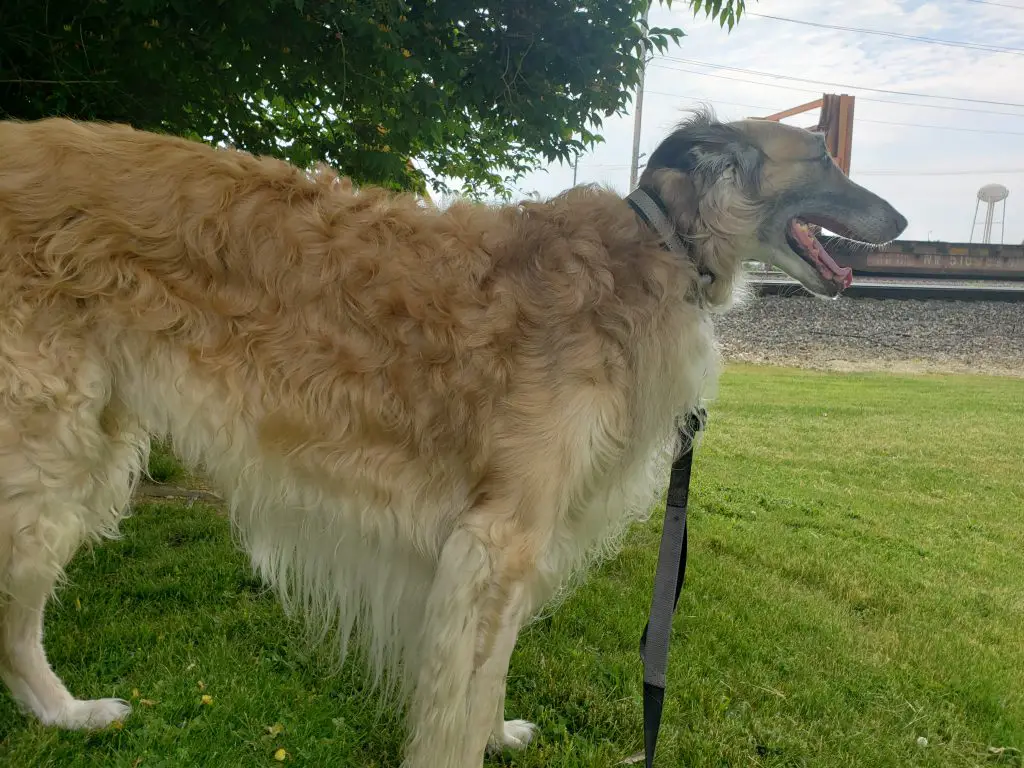
Never allow them unleashed in an unenclosed area. You will most likely lose them to the chase, whether they spot a stray cat or a plastic bag blowing in the wind.
Once these dogs start running, they’re difficult to distract and even harder to catch. They might race straight into traffic or run so far that you cannot find them again.
These family-loving pups can do well with children and other pets, but they must be socialized early in life. Otherwise, they might be prone to chasing your cat around the house at top speeds or trying to catch a child racing around the yard.
Remember not to leave small children alone with any dog, and that it’s just as important to teach kids to interact nicely with dogs as it is to train the dogs themselves.
These breeds are sensitive, and thus it’s even more important to use positive training techniques. Don’t yell at, punish, or try to dominate your dog.
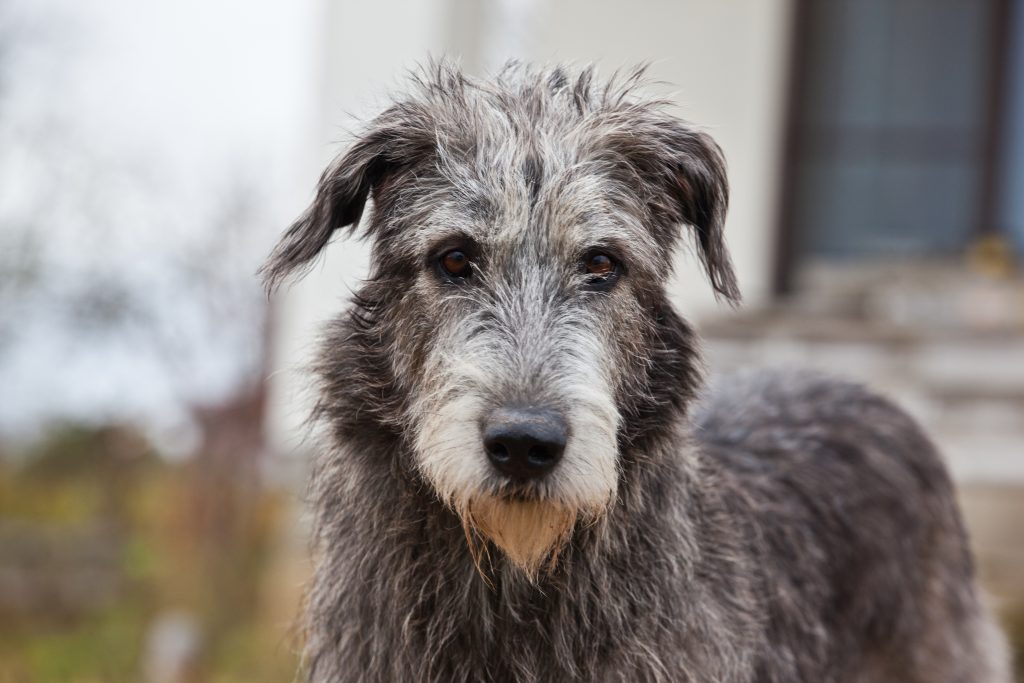
It’s a good idea to teach them how to be alone, as they can be quite clingy and may develop separation anxiety otherwise.
Borzoi vs Irish Wolfhound Exercise
It’s important that Borzois and Irish Wolfhounds get regular daily exercise as well as opportunities to run outdoors in a fenced yard.
Give them at least one daily walk or run in addition to playtime.
If you’re looking for some other activities, consider trying agility or lure coursing.
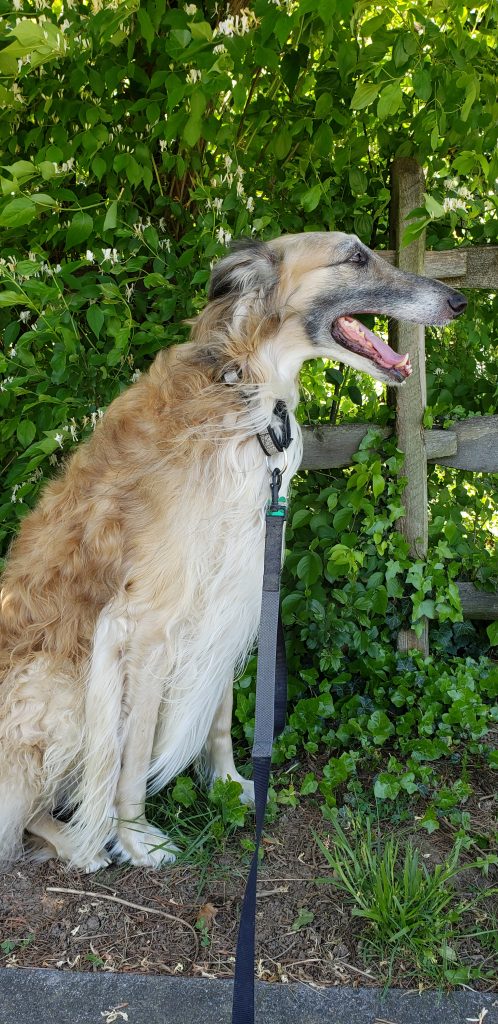
Borzoi vs Irish Wolfhound Grooming
Borzoi dogs have long, double coats that need to be brushed at least once every other day. Comb through their fur from top to bottom so that no painful mats are able to develop.
Regular bathing will help to keep their fur healthy and tangle-free.
Irish Wolfhounds also have double coats, however, theirs is lower maintenance and should be brushed once a week. Bathe them as needed.
Remember that double coats can be trimmed, but should never be shaved.
Both dogs shed an average amount. Other grooming requirements include regular teeth brushing, nail trimming, and ear cleaning.
Borzoi vs Irish Wolfhound Environmental Needs
Both Borzois and Irish Wolfhounds need large, enclosed yards to run in. While you might see these dogs on lists of “great apartment dogs,” they aren’t suited to that lifestyle without extra work, such as bringing them to a dog park regularly so that they have a place to run.
Ensure fences are too tall to jump, as these agile dogs might clear shorter fences and sprint off down the street.
Some dogs do well with small children and pets, while others don’t. Their prey drive might make them unsuitable for multi-pet households, in particular those with cats or small dogs.
If you’d like to adopt a Borzoi or Irish Wolfhound into your multi-pet household, look for one that’s been raised around animals or adopt a puppy and socialize them well.
These breeds are laid-back and not prone to problem barking, so they’re unlikely to bother the neighbors by being noisy.
However, they might be timid around new people, especially if they weren’t properly socialized as pups.
Borzoi vs Irish Wolfhound Health
Two common sighthound health problems are bloat and sensitivity to anesthesia. Because these are giant breeds, elbow and hip dysplasia are also common, as are heart and eye problems.
Whether you adopt a Borzoi or Irish Wolfhound, educate yourself on the symptoms of bloat. This deadly condition can kill a dog, especially when left untreated.
Symptoms of bloat include:
- Enlarged abdomen
- Retching
- Drooling
- Restlessness
- Pain in the stomach area, especially when touched
To avoid bloat, feed your dog proper portions and slow down their eating by using bowls with grooves on the bottom. Don’t exercise them too close to meal times, and keep their stress levels as low as possible.
Consider feeding your dog in a quiet area of the house away from other pets or children.
Genetics and gender also play a role, with male dogs being more prone to bloat than females.
Borzoi vs Irish Wolfhound History
Borzois were bred in the 1600s for Russian wolf hunts. When a wolf took off, a few Borzois would be unleashed to chase it down. They would then hold it in place for human hunters to either kill or capture.
They were bred to withstand harsh winters, thus their long, thick fur. To achieve this, Russians bred together Arabian greyhounds and an unknown, thick-haired Russian breed.
Irish Wolfhounds have a less certain history. British and Middle Eastern breeds were combined to create these giant, lovable pups.
This breed dates further back than the year 391, so they truly are ancient!
Later in the breed’s lifespan, they were used to hunt wolves in Ireland. They caused the extinction of many big-game animals in the area, and the breed almost ceased to exist itself because it was no longer needed.
Luckily, the breed was saved and the Irish Wolfhound still lives on to this day.
